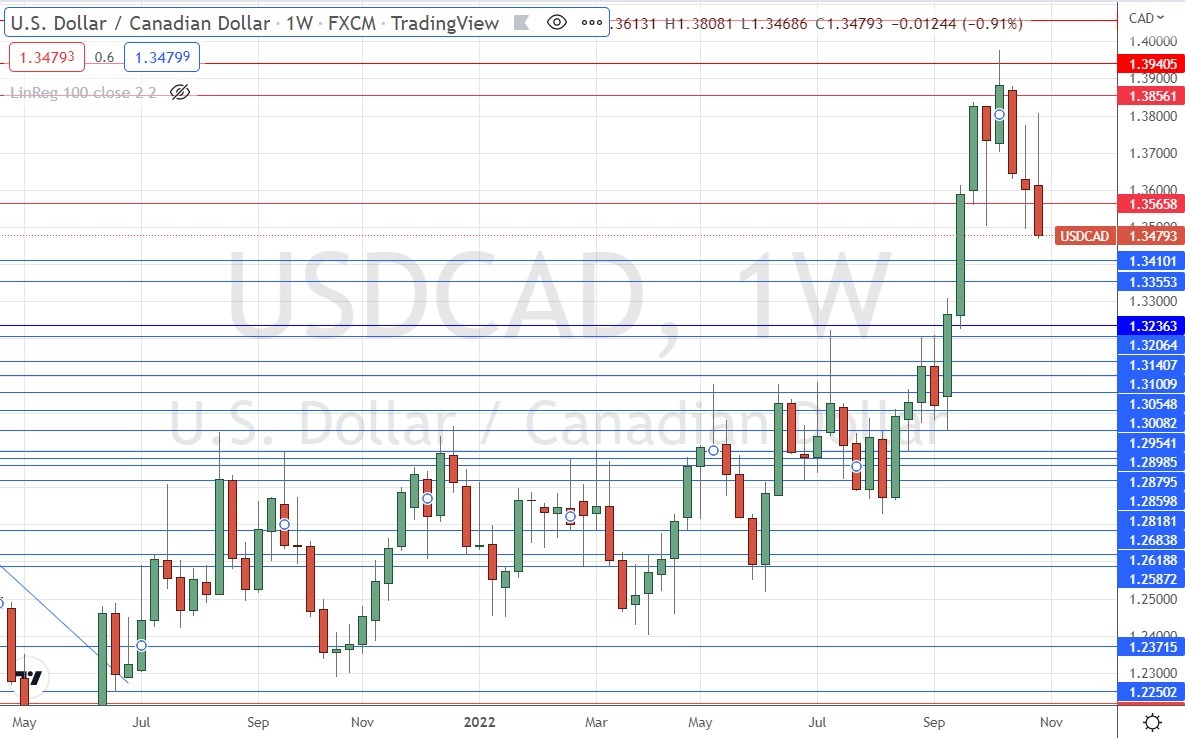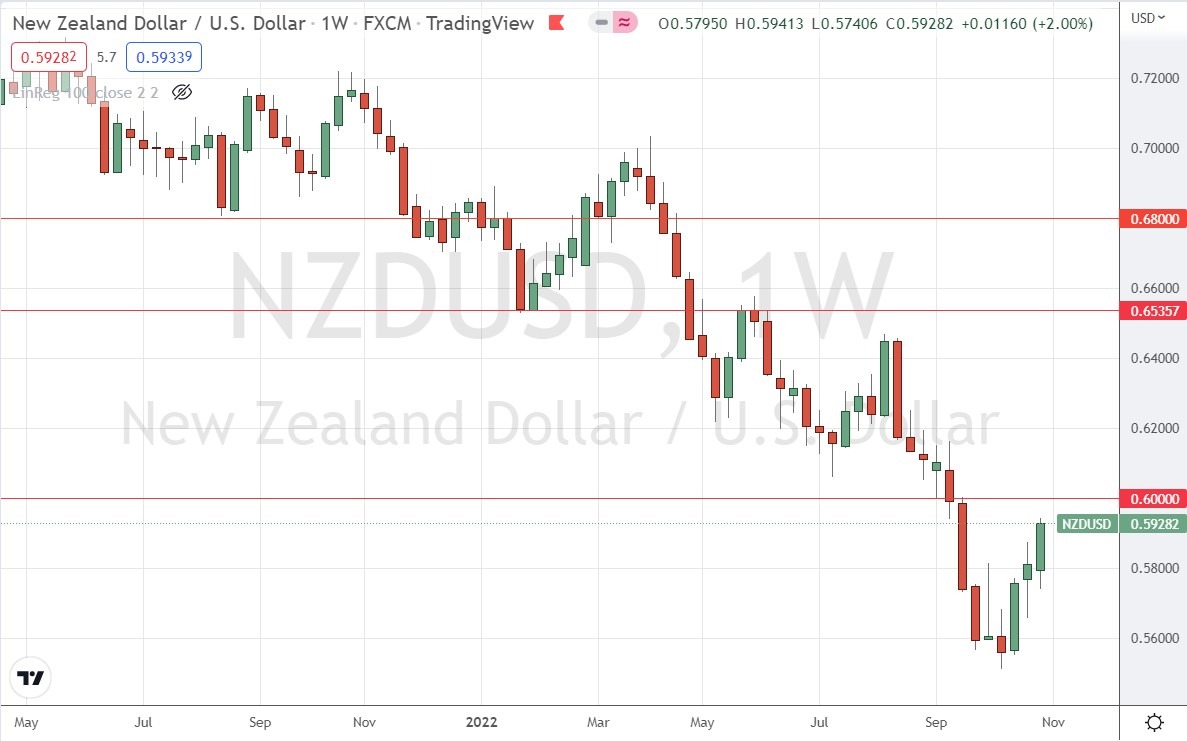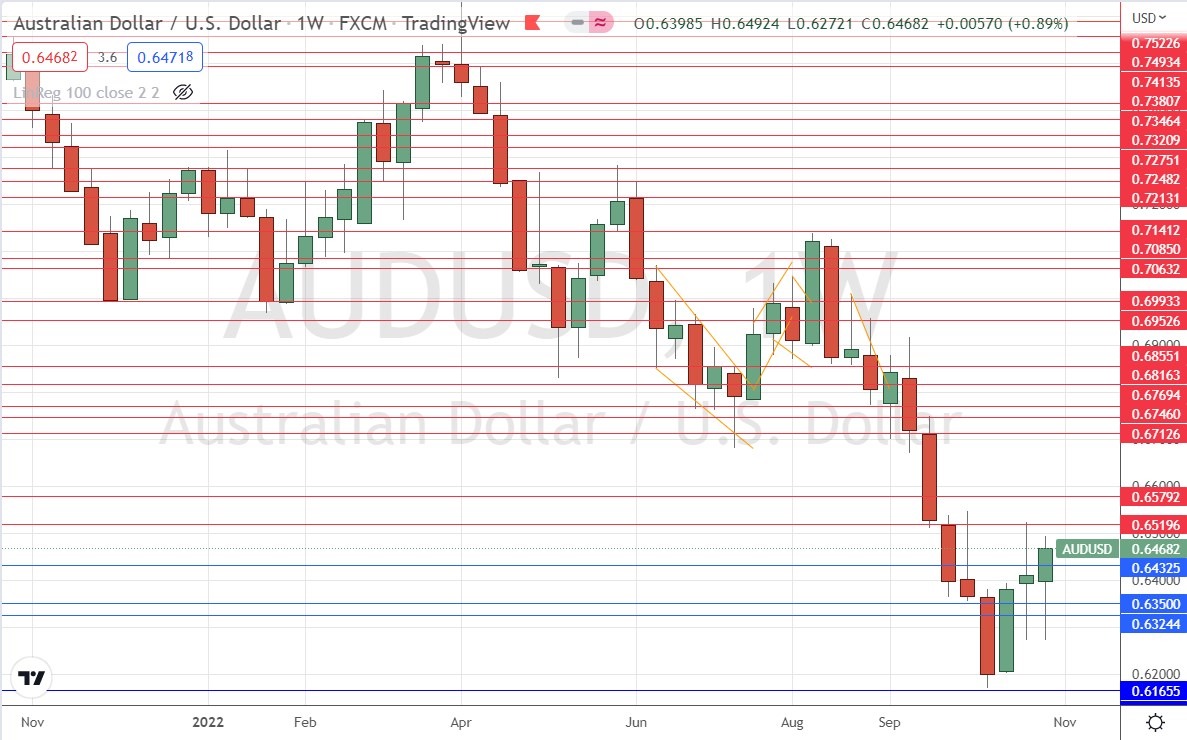Weekly Forex Forecast – USD/CAD, AUD/USD, NZD/USD
The US Dollar Index has traded sideways over the week, while the commodity currencies continue to be strong, despite ongoing weakness in most major stock markets.
The difference between success and failure in Forex / CFD trading is highly likely to depend mostly upon which assets you choose to trade each week and in which direction, and not on the exact methods you might use to determine trade entries and exits.
So, when starting the week, it is a good idea to look at the big picture of what is developing in the market as a whole, and how such developments and affected by macro fundamentals, technical factors, and market sentiment. There are some mostly short-term trends in the market right now, which can be exploited profitably. Read on to get my weekly analysis below.
Fundamental Analysis & Market Sentiment
I wrote in my previous piece on 16th October that the best trades for the week were likely to be:
- Short of the AUD/USD currency pair. The price rose by 2.80%, producing a large loss.
- Cautiously long of the USD/JPY currency pair to ¥150. The price rose by 0.99% to reach ¥150, producing a win.
These trades produced an overall averaged loss of 0.91%.
The news is currently dominated by last week’s rate hikes of 0.75% by the FOMC and by the Bank of England, both of which were widely expected. The FOMC hike of course got more attention, and it was accompanied by hawkish language which saw helped push the US 2-year treasury yield up to a multi-year high above 5%, before it fell back quite quickly, as the language implies the Fed could raise rates to above 5% in 2023. That release also saw the US Dollar strengthen, but it also gave up its gains by the end of the week.
A secondary item which helped cheer markets somewhat at the end of the week was stronger-than-expected jobs data from both the US, where the non-farm payrolls total came in well above expectations, and Canada. This confirms earlier positive GDP data which suggests that north America is no longer in a recession, if it ever was earlier this year, and it sent stocks higher and the US Dollar lower on Friday.
The details of the important economic data releases last week can be summarised as follows:
- FOMC Federal Funds Rate & Statement – the Fed hiked rates by 0.75% as had been widely expected and used hawkish language to indicate that rates may exceed 5% in 2023.
- US Non-Farm Payrolls – this came in well above expectations, showing the US economy is still robust, triggering a rise in stocks and a fall in the US Dollar.
- Bank of England – hiked rates by 0.75% as was widely expected.
- Reserve Bank of Australia – hiked rates by 0.25% as expected.
- Swiss CPI (inflation) – showed a lower-than-expected month-on-month increase of only 0.1%.
- US JOLTS Job Openings – came in well above expectations, showing strength in US economy.
- Canadian Employment – far more net new jobs were created in Canada last month than had been estimated, suggesting strength in the Canadian economy.
- US ISM Services PMI – this came in slightly worse than expected.
- US ISM Manufacturing PMI – came in slightly high, suggesting stronger manufacturing sector.
- New Zealand Employment – excessive new jobs were created, but the overall unemployment rate still rose slightly.
The Forex market saw relative strength in the New Zealand Dollar last week. The weakest currency was the British Pound.
Rates of coronavirus infection globally decreased last week, continuing a trend which began almost 4 months ago. The only significant growth in new confirmed coronavirus cases overall right now is happening in Japan.
The Week Ahead: 7th November – 11th November 2022
The coming week in the markets is likely to see a similar level of volatility as last week, as although there are only a few major data releases scheduled, these include very highly important US inflation data.
- US CPI (inflation) data
- US Congressional Elections (mid-terms)
- UK GDP data
- US Preliminary UoM Consumer Sentiment
Technical Analysis
U.S. Dollar Index
The weekly price chart below shows the U.S. Dollar Index printed a weakly bearish near-hammer candlestick which closed near the nearest major support level shown in the price chart below at 110.00. These are bearish signs, although there is no question that the long-term trend is very bullish, but the bullish trend does seem to have slowed down and may be making a major reversal.
I think the main thing to watch for here is whether the price can get established below the current nearest support level at 110.00. That would signify that the bullish trend is in serious trouble. However, it should be noted that US Dollar yields hit records highs only last week, so don’t write off the greenback just yet.
If you are going to trade against the US Dollar, it will likely make most sense to be long of commodity currencies, which are surging on the back of stronger local jobs and growth data.
USD/CAD
Last week saw the USD/CAD currency pair print a large bearish outside candlestick which closed very near the low of its range. We are seeing some weakness in the US Dollar as economic data emerges showing surprising robustness in major economies despite a series of rate hikes. The data is especially strong in Canada, which is showing strong growth in employment and better than expected GDP growth.
There is bearish momentum here, although it is not especially strong or long-term, but the bearish case is reinforced by the fact that there is no obvious strong key support until the $1.3225 area, which might prevent further movement downwards over the near term.
(Click on image to enlarge)

NZD/USD
Last week saw the NZD/USD currency pair print a large bullish candlestick which closed quite near the high of the weekly range. It is the third consecutive weekly advance after multi-year lows were reached in October.
The strongly bullish long-term trend in the US Dollar is now in question, and the New Zealand Dollar is strong, as are all the commodity currencies.
The US Dollar will likely not move much until the US CPI (inflation) data release later in the week, so we could well see continuing upwards movement in line with the healthy short-term momentum here in favour of the Kiwi. However, traders may prefer to pair the NZD as a cross, with a weaker major currency such as the British Pound.
Anyone trading this currency pair long should beware of potential resistance at the next big round number of 0.6000.
(Click on image to enlarge)

AUD/USD
Last week saw the AUD/USD currency pair print a bullish inside bar which closed not far from the high of the weekly range. It is the third consecutive weekly advance after multi-year lows were reached in October.
The strongly bullish long-term trend in the US Dollar is now in question, and the Australian Dollar is strong, as are all the commodity currencies. However, it is worth noting the New Zealand Dollar is even stronger, so it might be a better idea to trade the NZD/USD right now instead of this currency pair.
The US Dollar will likely not move much until the US CPI (inflation) data release later in the week, so we could well see continuing upwards movement in line with the healthy short-term momentum here in favour of the Aussie. However, traders may prefer to pair the AUD as a cross, with a weaker major currency such as the British Pound.
Anyone trading this currency pair long should beware of potential resistance at 0.6520.
(Click on image to enlarge)

Bottom Line
I see the best opportunities in the financial markets this week as likely to be making short-term trades long of the CAD and the NZD and using the GBP or another major currency showing short-term weakness as the short counterparty.
More By This Author:
United States Federal Reserve Raise Interest Rates by 0.75% Yet AgainEUR/USD Forex Signal: US Dollar Strikes Back Ahead Of FOMC Decision
USD/CAD: Progressive Volatility Via Speculative Price Action
Disclosure: DailyForex will not be held liable for any loss or damage resulting from reliance on the information contained within this website including market news, analysis, trading signals ...
more


